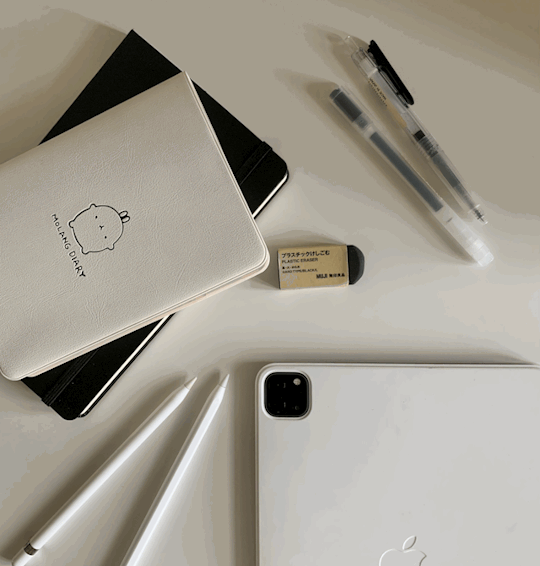Text
“MILIEU” AS A COMMONPLACE, III
To give readers insight about the challenges attached in developing a responsible curriculum, this blog has referred to William Schubert’s commonplaces of curriculum.[1] In that endeavor, the blog has reviewed all of the commonplaces and how they relate to any suggested curricular changes one might promote for civics education. It still has some commentary on the last of the commonplaces, milieu, to share. The last posting commented on the social expectations of schools and this one will address schools’ socio-economic concerns which undergird their base.
As explained earlier in this blog, Jean Anyon found the types of instruction and curriculum that schools offered were highly associated with the economic status of the children and adolescents who attended those individual schools.[2] In “working class schools” the tendency was for students to be exposed to instruction relying on rote work with little or no explanation, which leads to mechanistic learning.[3]
“Affluent professional schools” or “executive elite schools,” on the other hand, were much more apt to utilize instruction that had students engage in creative activities and independent work. This latter type of work is what is being proposed in this blog’s promotion of the liberated federalism mental construct. Such instruction allows students to develop analytical skills useful in adult life.
The consequence of this difference is that through the schools’ hidden curricula, they tend to reinforce the social and economic inequalities that already exist. Workers’ children are taught the skills and disciplinary dispositions expected of them at the workplace and managers’ and problem-solvers’ children and adolescents are expected to learn the skills they need to take the employment positions of their parents. This includes such positions as management and consulting work.
Jere E. Brophy, in the latter years of the past century, argued that the dichotomy of experience is not only one experienced in school, but further experienced in the home. The reviewed sources of this century do not reveal improvement[4] but describe how upper income parents, who usually hold more intellectually demanding employment, fill their households with discussion and conversation that have a more abstract quality. Brophy wrote:
I take the term “disadvantaged” to imply two things about a child’s background: (1) poverty and (2) gaps and limitations … so it should not be taken to imply limited potential, sensory or motor deficits, or learning disabilities … Disadvantaged backgrounds limit students’ readiness for school activities in both quantitative and qualitative ways. …
In addition to … quantitative limitations in disadvantaged students’ background experience, there are gaps and qualitative limitations in their development of cognitive and metacognitive tools for processing and making sense of their experience, transforming and storing this information in a form of codified knowledge, and assessing and applying it in relevant future situations.[5]
Of course, this condition of treating different socio-economic groups differently in terms of the educational advantages provided is an affront to the nation’s stated political value of equality.
This blogger, in a published article, argued that the educational product presented to lower income students should be different in terms of the level of abstraction in which the material is presented.[6] This is not to avoid abstraction but to recognize the exposure these students have had. This demands curricular constructs of content that are flexible enough to meet the different levels of abstraction that are of potential utilization. The judgment of this account is that its proposed model, the liberated federalism model, offers such flexibility.
The model is open-ended in terms of the specific conditions which might be portrayed under its use. Challenging political situations can vary from relatively simple concerns to highly complex ones. The portrayal of the compact-al, federated union can also vary in complexity. But its basic components are easy to understand and amply demonstrable by the experiences of any youngster.
Bonds formed among young friends in primary groups, for example, often exhibit the characteristics described under the concept, fraternal ethos.[7] Therefore, the judgment of this account is that the use of the liberated federalism model can meet the demands of the different income groups by allowing teachers or material developers to gear the material to appropriate levels of abstraction and therefore, provide the pathway to more meaningful and insightful understanding of governance and politics.
[1] William H. Schubert, Curriculum: Perspective, Paradigm, and Possibility (New York, NY: MacMillan Publishing Company, 1986). The commonplaces can be defined as follows:
The subject matter refers to the academic content presented in the curriculum.
The teacher is the professional instructor authorized to present and supervise curricular activities within the classroom setting.
Learners are defined as those individuals attending school for the purpose of acquiring the education entailed in a particular curriculum.
Milieu refers to the general cultural setting and ambiance within the varied social settings found at the school site.
Upon reflection, these commonplaces prove to be helpful in asking insightful questions.
[2] Jean Anyon, “Social Class and the Hidden Curriculum of Work,” in Curriculum: An Introduction to the Field, 2nd Edition, edited by James R. Gregg (Berkeley, CA: McCutchan, 1988), 366-389 AND for a more general overview on the ways financial resources have on education see “Does Money Matter in Education? Second Edition,” Albert Shanker Institute (2023), accessed October 28, 2023, URL: https://www.shankerinstitute.org/resource/does-money-matter-education-second-edition#:~:text=Schooling%20resources%20that%20cost%20money%2C%20including%20smaller%20class%20sizes%2C%20additional,positively%20associated%20with%20student%20outcomes.
[3] For a granular review of how money affects the quality of education students of various income levels receive, see Henry M. Levin, “On the Relationship Poverty and Curriculum,” North Carolina Law Review, 85, 5 (June 1, 2007), 1383-1418, (quotation below, page 1403). Here is a sample of that work:
The signs of different expectations are subtle but evident, even at the elementary school level. Schools serving lower-income students often stress following directions, while the middle class students are charged with critical analysis of school subjects." Teachers of low income students often place more emphasis on discipline, and children's experiences are circumscribed because of concerns that they will not behave appropriately if given challenging or enriching experiences or provided with too much independence.
[4] For example, see “Unequal Opportunities: Fewer Resources, Worse Outcomes for Students in Schools with Concentrated Poverty,” Commonwealth Institute (1921), accessed October 31, 2023, URL: https://thecommonwealthinstitute.org/research/unequal-opportunities-fewer-resources-worse-outcomes-for-students-in-schools-with-concentrated-poverty/.
[5] Jere E. Brophy, “Effective Schooling for Disadvantage Students,” in Better Schooling for the Children of Poverty: Alternatives to Conventional Wisdom, edited by Michael S. Knapp and Patrick. M. Shields (Berkeley, CA: McCutchan Publishing Corporation, 1991), 211-234, 211-212.
[6] Robert Gutierrez, “Teaching Secondary Social Studies to Low and Moderate Achievers: A Modest Proposal,” The Social Studies, July/August, 149-154.
[7] For readers new to this blog, the liberated federalist view promotes a view of state-building which depends on a sacred (either secularly or religiously defined) agreement in which founding parties come together to formulate the resulting polity. In turn, it counts of its citizenry to maintain a relatively high level of federation among its members. Hence, a “fraternal ethos” becomes important. The problem is that this nation has veered away from such leanings and has adopted a natural rights view with its high level of individualism to define how the citizenry defines governance and politics.
2 notes
·
View notes
Text
ingrid sundberg's colour dictionary - writing help

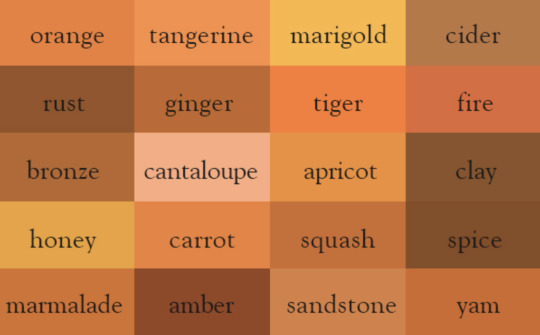
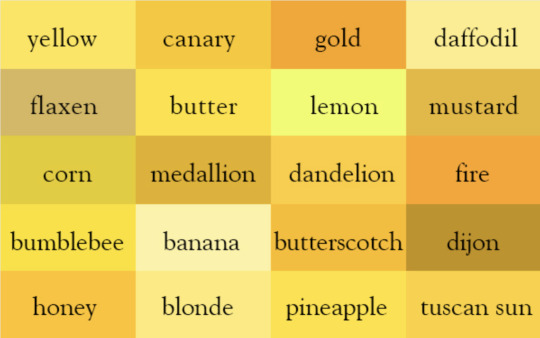
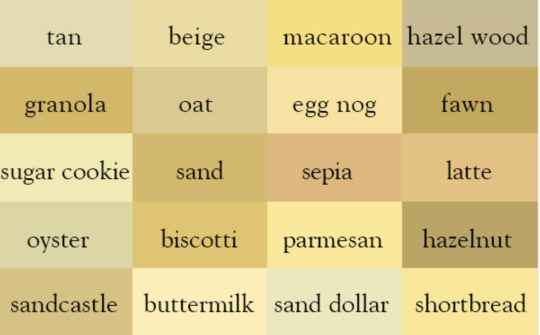
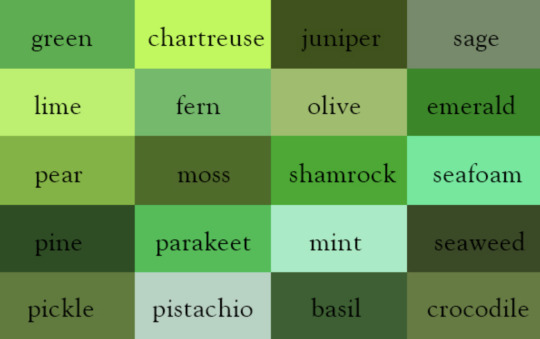
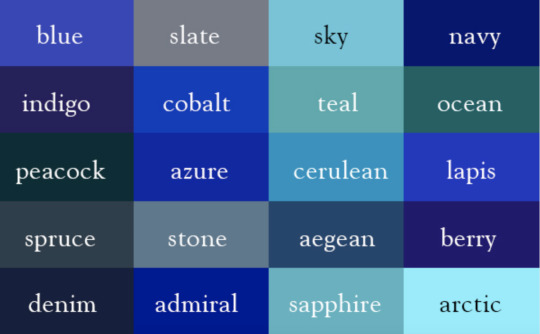


19K notes
·
View notes
Text
50 WORDS TO USE INSTEAD OF “SAID”
Do you ever find yourself over-using the word “said” in your writing? Try using these words/phrases instead:
stated
commented
declared
spoke
responded
voiced
noted
uttered
iterated
explained
remarked
acknowledged
mentioned
announced
shouted
expressed
articulated
exclaimed
proclaimed
whispered
babbled
observed
deadpanned
joked
hinted
informed
coaxed
offered
cried
affirmed
vocalized
laughed
ordered
suggested
admitted
verbalized
indicated
confirmed
apologized
muttered
proposed
chatted
lied
rambled
talked
pointed out
blurted out
chimed in
brought up
wondered aloud
(NOTE: Keep in mind that all of these words have slightly different meanings and are associated with different emotions/scenarios.)
64K notes
·
View notes
Text
Writing Tips
Punctuating Dialogue
✧
➸ “This is a sentence.”
➸ “This is a sentence with a dialogue tag at the end,” she said.
➸ “This,” he said, “is a sentence split by a dialogue tag.”
➸ “This is a sentence,” she said. “This is a new sentence. New sentences are capitalized.”
➸ “This is a sentence followed by an action.” He stood. “They are separate sentences because he did not speak by standing.”
➸ She said, “Use a comma to introduce dialogue. The quote is capitalized when the dialogue tag is at the beginning.”
➸ “Use a comma when a dialogue tag follows a quote,” he said.
“Unless there is a question mark?” she asked.
“Or an exclamation point!” he answered. “The dialogue tag still remains uncapitalized because it’s not truly the end of the sentence.”
➸ “Periods and commas should be inside closing quotations.”
➸ “Hey!” she shouted, “Sometimes exclamation points are inside quotations.”
However, if it’s not dialogue exclamation points can ask be “outside”!
➸ “Does this apply to question marks too?” he asked.
If it’s not dialogue, can question marks be “outside”? (Yes, they can.)
➸ “This applies to dashes too. Inside quotations, dashes typically express—“
“Interruption” — but there are situations dashes may be outside.
➸ “You’ll notice that exclamation marks, question marks, and dashes do not have a comma after them. Ellipses don’t have a comma after them either…” she said.
➸ “My teacher said, ‘Use single quotation marks when quoting within dialogue.’”
➸ “Use paragraph breaks to indicate a new speaker,” he said.
“The readers will know it’s someone else speaking.”
78K notes
·
View notes
Photo

ゴロゴロする
gorogoro-suru
Chill
Being couch potato
😶日曜日、何してたの?
What were you doing on Sunday?
😬何も。家でゴロゴロさてたよ。
I was just chilling at home.
😃😃😃
🔊Audio available. Link in bio @tomoe_sensei
——///
#nihongo #nihongojapanese #studyjapanese #日本語 #日本語勉強中 #日本語勉強 #にほんご #にほんごべんきょう #japones #learnjapanese #日本語 #japaneselesson #japaneseclass #learningjapanese #studygram #japanesestudygram
#日本語勉強
#日本語能力試験
#JLPT
#日语 #japanesewords #dailyjapanese #日本語交流 #japaneseidiom #japanesevocabulary #japaneseculture (at Japan)
https://www.instagram.com/p/CeppmiNFrqt/?igshid=NGJjMDIxMWI=
112 notes
·
View notes
Text
Crafting a language self-learning curriculum (sort of)
In my experience textbooks aren’t really the best way to learn after you’ve passed a certain level. They’re incredibly useful for beginners to learn grammar and vocab but after that they don’t offer a lot of activities that help you implement your learning in a way that reflects how you will actually use it.
It’s also near impossible to learn a language without help. Don’t isolate yourself just because you are self-learning rather than taking lessons. You NEED to talk to native speakers, both through text messages and actual verbal conversations. Colloquial conversations will differ greatly to formal an ‘correct’ ones spoken in a classroom.
1. The first step I suggest when creating a curriculum is to know what your goal is. Are you planning to move to the country the language is spoken in? Do you want to study as a way to better understand and appreciate the culture?
2. The next would be to gauge what level you are at through taking a language competency test. This is mostly so you have an idea of what you do know and what is considered the universal “next step” to give yourself a general direction to head towards.
3. Write down topics that interest you. For me these would be my career (marketing and digital media), my interests (video games, ttrpgs, fashion, history, horror novels), and important parts of my identity (my religion, my sexuality, my partner, my disability) etc. I didn’t bother writing down anything I already know such as how to talk about my family, how to talk about my country of birth, or hobbies commonly written in textbooks such as reading, swimming, camping.
4. Now come up with a list of general activities to cover your listening, writing, reading and speaking skills. Some examples are listed below:
Listening:
Watch 5 minutes of the news - recaps or weekly rundowns are great for this
Listen to an audio book for half an hour whilst cooking, cleaning, commuting etc.
Create playlists of music you actually like in your target language - you can further this by watching interviews about the artists or watching any live performances/streams they have done.
Writing:
Write 1-2 paragraphs about a chosen topic without any dictionary or vocab list aid, any words you cannot remember or do not know just write in your native language. Return with a dictionary to fill in these missing words after and ask a native speaker to make any corrections they can spot and finally rewrite everything with all the corrections (taken from Lindie Botes).
Write practice professional emails, blog-posts, product reviews, leave comments under Instagram posts etc. Make sure to learn how to write in different situations: how does writing an email to your boss differ from writing to your colleague? How are businesses addressed on review sites? What changes when writing a blog for fashion from one about politics? Learn these nuances.
Text your native speaker friends - simple but necessary
Reading:
Read and summarise a key news article from this week
Read a page from a book in your target language, highlight any unknown words to return to. Write out the sentences these words occurred in then the words on their own with their definition and create a new sentence using them. My key tip for this is not to be too ambitious with what you are reading. Don’t try to read an epic fantasy, instead focus on short stories and books for children aged around 5-10. As you improve you can read more complicated plots but just because you are familiar with the book in your native language does not mean you will understand what is going on.
Speaking
Record yourself leaving fake voice mails. This can be for a doctor’s appointment, inquiring about a job, asking to hangout with a friend etc. Keep it short and tone appropriate. This also gives you the opportunity to research phone etiquette in that culture.
Talk. To. Native. Speakers.
5. Combine your topics of interest with activities to give you something that should resemble almost a lesson plan.
Example:

337 notes
·
View notes
Text
16 Chengyu (成语) Patterns
As you may or may not know, I really like learning chengyu. After a while, I started to notice patterns and similar structures, and I got curious. What are the common patterns for chengyu?

There are a lot of chengyu, and I’m not that ambitious. I decided to just focus on the chengyu I know. Fortunately, pretty much all the chengyu I know are in Anki, so I was able to export them for analysis! I identified 16 of the most common patterns. Let’s take a look~
不可_ _
不可思议 bùkěsīyì - inconceivable / unimaginable / unfathomable
不可理喻 bùkělǐyù - to be impervious to reason / unreasonable
不可避免 bùkěbìmiǎn - unavoidably
不可或缺 bùkěhuòquē - necessary / must have
不可救药 bùkějiùyào - incurable / incorrigible / beyond cure / hopeless
无所_ _
无所畏惧 wúsuǒwèijù - fearless
无所不有 wúsuǒbùyǒu - to have everything
无所顾忌 wúsuǒgùjì - to have no misgivings / to stop at nothing
无所事事 wúsuǒshìshì - to have nothing to do / to idle one’s time away
无所不谈 wúsuǒbùtán - to talk about everything
不_不_
不折不扣 bùzhébúkòu - a hundred percent / to the letter / out-and-out
不屈不挠 bùqūbùnáo - unyielding / indomitable
不理不睬 bùlǐbùcǎi - to completely ignore / to pay no attention to / not to be in the least concerned about
不言不语 bùyánbùyǔ - to not say a word / to keep silent
不闻不问 bùwénbúwèn - not to hear, not to question / to show no interest in sth / uncritical / not in the least concerned
A lot of these contain words within them: 折扣、屈挠、理睬、言语、闻问 are all words!
一_不_
一丝不苟 yìsībùgǒu - strictly according to the rules / meticulous (lit. not one thread loose)
一成不变 yìchéngbúbiàn - nothing much changes / always the same
一尘不染 yìchénbùrǎn - selfless and incorruptible / spotless (lit. untainted by even a speck of dust)
一蹶不振 yìjuébúzhèn - a setback leading to total collapse / unable to recover after a minor hitch (lit. one stumble, unable to rise)
一丝不挂 yìsībúguà - absolutely naked / without a stitch of clothing (lit. not wearing one thread)
无_无_
无影无踪 wúyǐngwúzōng - to disappear without trace
无穷无尽 wúqióngwújìn - endless / boundless / infinite
无声无息 wúshēngwúxī - silent / unknown (lit. not a sound nor breath)
无边无际 wúbiānwújì - boundless / limitless
无忧无虑 wúyōuwúlǜ - carefree and without worries
A lot of these also contain words within them: 影踪、穷尽、声息、边际、忧虑 are all words!
一_一_
一心一意 yìxīnyíyì - concentrating one’s thoughts and efforts / single-minded / bent on / intently
一言一行 yìyányìxíng - every word and action
一举一动 yìjǔyídòng - every movement / each and every move
一朝一夕 yìzhāoyìxī - in a short period of time / overnight (lit. one morning and one evening)
一生一世 yìshēngyíshì - a whole lifetime all my life
Once again, we have some words: 心意、言行、举动、朝夕、生世 are all words!
Keep reading
272 notes
·
View notes
Text
Spices in Chinese

In my totally unbiased opinion, one of the best things about learning Chinese has been learning about Chinese food culture. Chinese food uses a dizzying array of spices, but these are the most common that you'll see in recipes. Learning these words might even help you find your way around your local Asian grocery store!
The Basics:
鹽 (yán): salt
糖 (táng): sugar
- Not technically spices, but salt and sugar are essential seasonings in Chinese cooking. Sugar is often used to provide balance in savory dishes, especially in the food of certain regions such as Shanghai.
味精 (wèijīng): MSG
-MSG is also a common ingredient (but not really a spice), and not associated with the same racist health panic as in the US. Some chefs, however, see it as "cheating" and prefer to impart umami through traditional ingredients like dried mushrooms and high-quality stock.
粉 (fěn)/面 (miàn): powder
- These two words can be stuck to the end of the spices below to indicate that they are ground instead of whole.
Spice Mixes:
五香粉 (wǔxiāngfěn): five-spice powder
- A sweet-and-savory spice mix well known around the world, five-spice powder tends to include star anise, Sichuan peppercorn, cinnamon, fennel and cloves.
咖哩粉 (gālífěn): curry powder
- British colonization brought curry to Hong Kong, where it's popular with beef or fish balls.
燒烤料 (shāokǎoliào): barbecue spice mix
- This doesn't refer to char siu, but to the spicy grilled meat skewers that are popular across China. A typical version hailing from the north-west is based on cumin and chili powder.
Spices:
胡椒 (hújiāo): pepper
- Chinese makes use of both white pepper (白胡椒) and black pepper (黑胡椒), but white pepper is more common.
花椒 (huājiāo): Sichuan peppercorn
- This is the spice that gives Sichuan food its famous numbing quality, though it is used all across China as well. It comes in red or green varieties, and can be used fresh or dried.
辣椒 (làjiāo): chili pepper
- Spicy food is popular in Sichuan and the rest of China's southwest, where tons of chili varieties are used fresh and dry-- this alone could be material for an entire vocab list.
八角 (bājiǎo): star anise
- One of the most iconic spices in Chinese cuisine, its name literally means "eight horns". It's commonly tossed into stews and braises.
肉桂 (ròuguì)/桂皮 (guìpí): cinnamon
- The cinnamon commonly used in Chinese cuisine is in fact cassia, which is stronger-flavored but less aromatic.
丁香 (dīngxiāng): clove
- A key ingredient in five-spice powder and occasionally tossed into braises. Interestingly, many of the sweet spices that we associate with desserts in the US are not commonly used as such in Asia. A friend once told me that many Taiwanese people don't like cinnamon desserts because they find the taste medicinal.
茴香 (huíxiāng): anise seed
- This spice is featured in Lu Xun's story Kong Yiji, where Kong Yiji asks the young narrator if he can write the character 茴, which is used in the name of the tavern's peas with anise.
香葉 (xiāngyè): bay leaf
- Bay leaves are used in China in much the same way as in the US-- tossed into stews and braises to provide a little... well, nobody knows what a bay leaf tastes like but it must be doing something.
陳皮 (chénpí): aged tangerine peel
- American-Chinese classics like orange chicken are likely influenced by stir-fries made with this bitter and fragrant peel.
百荳蔻 (báidòukòu): white cardamom
- Chinese food doesn't use the green cardamom commonly used in Indian food, instead preferring to use white cardamom in braised dishes.
草果 (cǎoguǒ): black cardamom, tsao-ko
- Black cardamom is dried over a fire, giving it a distinctive smoky flavor. While not overly common in much of China, it is one of the most common seasonings used in Yunnan food.
孜然 (zīrán): cumin
- Cumin is also not a flavor commonly associated with China, but it's iconic of the food of China's northwest, such as Shaanxi and Xinjiang.
甘草 (gāncǎo): licorice root
沙姜 (shājiāng); sand ginger
當歸 (dāngguī): angelica root
- These three spices are all known for their uses in traditional Chinese medicine, but are also used in medicinal soups and larger spice mixes. There are, of course, way more TCM herbs and spices used in Chinese cooking, but these are the most common to see in recipes or dishes.
171 notes
·
View notes
Text
The Senses in Japanese

感覚 かんかく sense
感じる かんじる to sense, to feel
五感 ごかん the five senses
触覚 しょっかく sense of touch
感触 かんしょく touch
触る さわる to touch
視覚 しかく sense of sight
視力 しりょく sight
見る みる to see
聴覚 ちょうかく sense of hearing
聴力 ちょうりょく hearing
聞く きく to hear
嗅覚 きゅうかく sense of smell
匂い におい smell
嗅ぐ かぐ to smell
味覚 みかく sense of taste
味 あじ taste
味わう あじわう to taste
八識 はっしき eight consciousnesses (the five senses, consciousness of the mind, self-consciousness and store consciousness) - Buddhism
337 notes
·
View notes
Text
“Fairy tale does not deny the existence of sorrow and failure: the possibility of these is necessary to the joy of deliverance. It denies (in the face of much evidence, if you will) universal final defeat…giving a fleeting glimpse of Joy; Joy beyond the walls of the world, poignant as grief.”
—
J.R.R. Tolkien (via castlesofsnow)
I literally gasped then cried when I got to this part of this essay.
(via resurrecttheliving)
4K notes
·
View notes
Text
Film An Introduction - William H. Phillips - Page 11-59 - Chapter 1: Mise en scène
Phillips explains the importance of mise en scène in the realm of film by stating that it can be ‘so expressive’ that sometimes ‘only a few selected images can convey a good deal of a film’s story, moods, and meanings’. Major scenes may convey as much of the story, the character’s themselves, and the themes of the narrative using only visuals. This may undermine the power of the film score which is rarely absent in such moments. Sound adds and often spurs on the impact visuals may have.
Philllps considers the components of the mise en scène as the settings, the subjects being filmed, the composition, and the lighting.
Settings
This is ‘the place where filmed action occurs’. The setting can either be a ‘constructed place’, built specifically for filming, or it may be ‘on location’, a real place. The use of settings in films can have a ‘tremendous impact’ on viewer’s experience, and can often suggest a time period, and location, or it may ‘enhance style, character, mood, and meaning’.
Types of settings
Although some settings may be built in a studio, some, and this is often the case in science fiction films of recent years, may be built digitally and then transferred to film. Typically, films are ‘shot’ on a set or on location, and sometimes a film may ‘combine shots’ on a set with those made on location.
Phillips also remarks that a setting may be the ‘main subject’ of a scene, however similarly, at the opposite end, the setting may ‘draw no attention to itself’. In these cases, the setting my be blank ‘(limbo)’ or ‘out of focus’.
‘Realistic settings’ are another type of setting, in which the setting is built to ‘convince’ the viewer that they are looking at a real place, that the setting could exist. This helps the viewer get caught up in the ‘world and action of the film’. ‘Non-realistic settings’ are built settings that are intentionally built to not look realistic, by exaggerating or by lacking the ‘right details to convince audiences’. For example, non-realistic settings may include ‘unexpected colors’ which, Phillips suggests, may be enjoyed for their ‘creativity and whimsy’. Non-realistic settings can also convey a character’s state of mind.
Different films require different settings to establish themes and characters, however, in films where the budget is tight, non-realistic settings are more common as they may be ‘cheaper’ and ‘faster to construct’ than the detailed realistic ones.
Functions of Settings
Phillips states that above all ‘settings indicate place and time’. The film may shift to a new location and may not need to state so as the real life locations, their architecture, the people, the fashion/costumes, the plants, and geographical marks will all state this. One scene that takes place in a snow blizzard, that follows a scene that takes place in sweltering jungle, suggests a change in location, possibly a change in time. The type of cars, or technology, the fashion again, can also suggest the time period, whether it be modern day, the past, or the future. Phillips also points out that the audience ‘scarcely needs the soundtrack to reveal that the action shifts’ to a new setting. Settings establish themselves and stand a part from one another
Phillips uses the example of films set in space as he states that filmmakers may ‘dwell’ on the settings, which may not advance the narrative, but will ‘stress the beauty, wonder, and vastness of nature’.
‘Loose framing’ is when a shot ‘presents the main subject with abundant space around it’.
‘Tight framing’ is when there is ‘little space around the subject’ and this leads to settings conveying a sense of ‘confinement and stress’. Phillips comments that this type of framing may be used until someone ‘abruptly intrudes into the image’ - this is more common in horror or thriller films, and is often seen as a ‘technique to frighten a character and viewers’ but then immediately establish itself as not a threat.
Settings can also be used to establish what a ‘character is like’ or to ‘create or to intensify moods’. A setting that takes place in a damaged or desolate landscape, can imply an unhealthy mindset of the character. ‘The land itself looks ready to give up’, as Phillips writes of an example. Settings can be symbolic. How character’s interact with the setting or influence/alter the setting can also be an indicator of a character’s abilities, personality, mood, etc…
‘Where characters live, or work, which objects surround them, and how they arrange those objects ca also tell us much about the characters’. The initial setting may represent a character in their mood or state of mind, it may serve meaning.
Settings throughout a film can be used to ‘mirror changes in situation and moods’.
Subjects
Subjects are ‘crucial’ in understanding the ‘expressiveness’ of mise en scène. The subjects in fictional films are usually the characters.
Action, Reaction, and Appearance
Phillips states that viewers learn about the subjects by ‘observing their actions’, what the characters are doing at a given moment. If a character is seen at a typewriter, the audience infers that the character is perhaps a novelist. Viewers can also ‘learn volumes’ through a character’s ‘facial reactions’.
‘Reacting … I think is the essence of acting. And just tiny things can fleet across his face and say a lot more than probably pages of dialogue.’ (Jim Jarmusch)
Phillips remarks that ‘actions and reactions are the usual means of revealing characterization’ which he ponders whether this is because films can ‘single out’ actions and reactions as films can put focus on them, they can show an action in a memorable way. The audience does not need to be told what qualities a character may have, their personality, what they are capable of, what they are not capable of. All of this can be understood through the action or reaction of a character, all of this can be shown through film, rather than told.
Moreover, a character can be understood through their possessions. This may come under a category of props. Phillips notes that vehicles are a common way to show a characterisation: ‘station wagons for family members, sports cars for independent singles, VWs for the unassuming, and Volvos for the cautious and middle-aged’. In some instances, the choice of vehicle may ‘surprise or amuse audiences’.
Moreover, the audience can infer a lot from the character by their physical characteristics. For example, ‘posture, gesture, clothing, makeup and hairstyle’. In instances where there are many main characters, costuming, posture etc… can be used to ‘individualize’ them. Moreover, clothing can be used to ‘show’ or ‘reinforce’ an aspect of a character.
In this sense, the appearance of a character may serve to ‘heighten the contrast’ between two opposing figures. It may hide a character’s identity, or represent the character at different ages, or in a changed situation. Costumes are often used to ‘help show a place and time’ but it can also convey a character’s ‘status and power’.
Phillips remarks that appearance can be ‘so expressive’ that it can sometimes convey ‘the essence of a story’. In Crimson Peak the audience watches as Edith’s bright yellow clothing becomes subdued as the film progresses, suggesting her depression, the effect of her husband and his sister trapping her within the decaying property, and the poison she is drinking that is draining the life from her.
Phillips also states how appearance can not only reveal a character, but create a character.
Costumes serve as indicators of gender and social status, but they also shape bodies and behavior. “[We] may make them take the mould of arm or breast,” Virginia Woolf wrote in Orlando, “but they mould our hearts, our brains, our tongues to their liking.” … Who shall say how much the lumbering work of Frankenstein’s monster was created by [Boris] Karloff and how much by a pair of weighted boots? We even have Chaplin’s word that the Tramp grew out of the costume, not vice versa: “I had no idea of the character. But the moment I was dressed, the clothes and make-up made me feel the person he was.” (88-89)
Character and Acting
‘Characters are imaginary personages in a fictional story’ writes Phillips. Characters are often based on real life people, or at least, partly based, carrying several traits of a person. However, characters (typically those of action films) are completely imaginary. Therefore, a character’s action and language, their ‘thoughts, dreams, and fantasies’ are the ways in which the audience can understand them.
‘Round characters’ are ‘complex, lifelike, multidimensional, sometimes surprising, and changeable’. These are the most important characters of the story.
‘Flat characters’ are ‘simple (stereotypical or minor), one-dimensional, and unchanging’. These characters typically play the minor roles of a story. They appear in few scenes, and rarely have an affect on the most significant parts of a story.
Narrative films will typically only have a few round characters as film only has time to develop few characters in depth. According to Phillips, most viewers find it too ‘confusing’ to keep track of ‘more than a few major characters’.
Types of Actors
Far from the movies not being an actor’s medium, there’s probably been no other artistic medium in this [twentieth] century whose appeal rests so strongly on the human presence, and in which the human image has occupied a place of such primary and centrality (Pechter 69)
Actors may adopt a style of acting, which critics and film theorists have divided into four groups: stars, Method actors, character actors, and nonprofessional actors.
Film stars are common in the cinema of the United States, as well as in other countries such as France and India. These actors will typically play the major role in a film, or at least a major role. Particular film stars, Phillips uses Arnold Schwarzenegger as an example, will usually be cast to play a ‘very narrow range of characters’ but they often ‘generate widespread interest’, ‘command enormous salaries’, and will often ‘guarantee a large box office’ both in the United States and internationally.
Stardom seems more a state of being than a learned skill … For a performer like Stallone … the ability to convey very subtle shades of emotion, to enter personalities foreign to him, is essentially irrelevant. His skill is that of existing intensely on screen, of communicating his uniqueness and inviting audiences to enjoy it and identify with it (Kehr)
‘Stardom’ or star power, can come with a lot of ‘prestige’ and ‘power’. An actor who has reached this level can make demands of their own, altering the film’s direction, and can even have their own influence on the script; whether they demand it themselves or the script is written with them in mind.
Method actors will attempt to ‘figure out’ the mind of the character they are portraying before filming starts. An infamous example of method acting is Dustin Hoffman staying awake for three days before filming a scene in which his character has also been awake for three days.
Method actors will aim to ‘become the character’ and may use people they know from their own lives as a blueprint for their portrayal, or they may remember situations, interactions with a person, and adapt their quirks, temperaments, or personality into their work. Actors may also change their physical appearance, sometimes drastically, to look and feel the part.
Character actors will ‘specialize’ in the ‘same type of secondary role’. These actors will portray a similar type of character with each role they play.
Nonprofessional actors are people with no training or experience in the profession. Some directors may purposely hire local people to achieve a particular mood or effect to the film, or perhaps to state an ideology. Moreover, it may take pressure off the film as audiences will not be distracted by the lives or actions of the actors outside the film.
However, in some cases, directors have no choice but to use nonprofessional actors. This is usually the case in countries with widespread poverty where trained actors are ‘not available’ - either because the film has no budget or none are available locally.
Sometimes nonprofessional actors can be ‘so awkward’ and ‘self-conscious’ that they are distracting, ‘even unintentionally laughable’. However some directors can get an effective performance from nonprofessionals.
A ‘cameo’ is a ‘small part’ played by famous actors, or other famous people. The director may play a small part in the film, for example M. Night Shyamalan and Alfred Hitchcock would often play a small part in their films. This can become a ‘type of cinematic insider’s joke’ and are regarded by Phillips as ‘little unexpected treats’ for the audience. A cameo may contribute very little to the narrative of the film but are there to be playful or enjoyable.
Process and Performance
Improvisation is a technique favoured by some directors and actors. Actors are able to say or do something ‘spontaneously’ in the middle of the take within the circumstances the character is in. The idea is that the improvisation performed by an actor ‘immersed’ in the character and scene is ‘likely to be truer’ to the character and situation that what has been imagined by the writer.
Phillips explains that an actor’s ‘best allies’ are a skillful scriptwriter, a director who is able to effectively set the context and mood of each shot, and an editor who selects the best take, or shortens an ineffective shot, or tidies up the performance through professional cutting. In this way, the director, writer, and editor, ‘may strongly shape a performance’.
An effective performance can ‘persuade’ audiences that the character is ‘believable’. This keeps viewers involved in the story. However, Phillips reminds that there is no performance that is always completely effective. The believability of a performance is dependent on the ‘film’s style’ and ‘to some extent on the viewer’s culture’. Some films work best when the acting is ‘restrained’, whereas others require a performance that is ‘exaggerated’. Phillips expresses that acting should not be judged by ‘one absolute standard’ but ‘in light of the kind of film it is in’.
Phillips also explains that acting is perceived to be an ‘invisible art’, therefore making it difficult to judge.
Composition: The uses of space
Composition is what Phillips refers to as ‘the final major aspect of mise en scène’. While mise en scène refers to what is in the frame, composition is how these items are arranged - how lighting and subjects are ‘arranged in relation’ to each other and ‘to the sides of the frame’.
When composing the image, Phillips offers the following questions that filmmakers may ask themselves;
What shape should the image be?
When should empty space be used?
Should the arrangement of subjects on the sides of the frame or in the foreground and background be used to convey or reinforce a meaning or mood?
Should the width and depth of the image be used expressively within the same shot?
Should the objects of main interest within the frame balance each other or not?
Shape of the Projected Image
The aspect ratio ‘indicates the shape of the image’ - specifically the relationships of the image’s width to its height. The standard aspect ratio 4:3 means that the imager is wider than it is tall by a ‘factor’ of 4:3. Historically, the projected image has always been wider than it is tall, with the standard aspect ratio being used primarily between 1910 to the early 1950′s when wider aspect ratios began to be popularised.
Frequently used aspect ratios:
1.33:1 or 4:3 - standard aspect ratio
1.66:1 - aspect ratio used for most European theatrical showings
1.85:1 - aspect ratio used for most US theatrical showings (since the 1960s)
2.4:1 - aspect ratio of current anamorphic (wide-screen) showings
2.75:1 - aspect ratio of Ultra-Panavision 70
It is possible for the aspect ratio to be changed during the film, widening or shortening the projected image for specific meanings. One way this can be done is through the ‘iris shot’ in which parts of the image are ‘obscured by a process called masking’. This results in a geometric shape, usually a circle, capturing the image while surrounded by a particular colour, usually black. Sometimes part of the projected image may be ‘illuminated’ while obscuring other parts. These techniques help in directing the viewer’s attention ‘to the visible subject’.
Empty Space
Phillips states that empty space is used to ‘convey a sense of loss’ in the film’s narrative. However, he also reminds that empty space, ‘like everything else in a film’, has ‘no inherent meaning’. Thus, the meaning is applied by the context. He offers that empty space may suggest loss, but it can also have positive connotations, such as ‘power’ and ‘freedom’. Empty space can also be used to the advantages of thriller films - as Phillips states
If we see largely empty space in a shot followed by something intruding abruptly, the results can be startling.
A character or an action may ‘burst’ into a character’s space, but also into the viewer’s.
Taking Sides
Another way to use the width of the image is ‘expressively’. Two characters shown on opposite sides of the frame ‘suggest their alienation from each other’. It may also suggest two opposing forces, a challenging stance inferring their opposing beliefs.
Sometimes filmmakers may use ‘split-screen techniques’ to show more than one image at the same time. This has the implication that the events shown are happening ‘at the same time’. However, it can also contribute to the suspense of a film, or highlight the ‘characters’ similarities’.
Split-screens can also be used to reveal an action and the multiple reactions of characters. Another way filmmakers can achieve this without split-screens is through reflections. A character may look at the reflective surface, and the audience is able to see what or who they are looking at as well as their reaction to what they’re seeing as in this scene from Death Becomes Her (1992) in which the maid enters the room of Madeline Ashton (Meryl Streep). It appears as though the maid is behind Madeline but it is revealed later in the scene that the audience was watching the maid through the mirror behind Madeline’s bed.
By using the reflective surface, filmmakers are able to ‘maintain’ continuity of action, time, and space rather than ‘divide the information’ into multiple shots. In this way, Phillips states that the filmmakers ‘choose to communicate the information by the composition of a single shot’ rather than by the editing.
Foreground and Background
How actors are arranged in the background and foreground are ‘opinions that influence what the images communicate’. An action in the background may go unnoticed because ‘its obscurely lit’ or ‘out of focus’ or because the foreground draws the viewer’s attention. However, sometimes a dangerous character lurking in the background or an out of focus action can become the focus of the viewer’s rather than what is happening in the foreground. This being a case for another scene in Death Becomes Her in which Ernest (Bruce Willis) calls Helen (Goldie Hawn) to announce the death of Madeline. In this shot, Ernest is centred as his actions are the most important, and Madeline’s twisted corpse lies in the background out of focus. As the scene moves forward, so does the camera, closing in assumably on Ernest, but is really pushing him to the side of the frame as the real focus become the blurred Madeline who suddenly begins to twist her body behind Ernest. The actions of the camera are initially unnoticeable as the audience waits to see what will happen next. The eye is being directed to Madeline without the audience being fully aware of it.
Sometimes, as Phillips suggests, the background may influence how viewers respond to something in the foreground, or vice versa.
Another way to direct viewer’s attention is by using ‘rack focus’ which allows filmmakers to change the focus ‘during’ a shot ‘(usually rapidly)’ between the foreground and background. This seamlessly shifts viewer’s attention from the actions in the background to what is happening in the foreground. Phillips suggests this typically happens during ‘a dramatic moment’ or ‘while the primary subject of the shot is moving’ or both. The viewer is not meant to notice this change.
Using reflective surfaces or rack focus is an ‘alternative’ to editing and ‘maintains continuity of action, space, and time’.
The way elements in a shot are arranged can imply the importance of an object or person to someone in the foreground. Other times, the audience may witness something important in the background that the subject in the foreground is unaware of.
Moreover, action in the background may compete for attention with the action in the foreground. Phillips states how filmmakers may film ‘through’ an object with the background capturing the audience’s attention and the foreground typically being ignored - how the object in the foreground that is being filmed through relates to what is happening in the background may go ignored by casual movie-goers. The typical implications of this method is that the character in the background is suffering from ‘entrapment or imprisonment’.
Sometimes both the width and depth of a shot are used ‘expressively’.
Symmetrical and Asymmetrical Compositions
In a symmetrical composition with only ‘one major subject’, the subject is seen in the ‘approximate center of the frame’. In symmetrical compositions with two subjects, ‘typically both are on opposite sides of the frame’ or they may be near the centre. An image with many subjects can be ‘symmetrical’.
In asymmetrical compositions, the shot may not be balanced. This can suggest the character (if the shot happens to only include one subject) is unbalanced. Phillips suggests that a films may asymmetrical compositions ‘more than occasionally’.
2 notes
·
View notes
Text
Day 24 - blur
Day 24 of my July Writing Challenge
I will pass through this life in a blur, my existence flickering out like a flame. My name will not go down in history, it will not be remembered and nor do I have any desires for it to be. Some people wish to be known and why not? There is something beautifully human about it. When we live day after day, each person who walks this earth fighting their own battles, is it not a small thing to say ‘I lived, I fought, please remember me’ when it is over.
We all become stories, a myriad of new beginnings, tragedies, romances, broken hearts and happy endings. Whether we are novels or vignettes, we all had our own story. We were someone. Some people do great things, they save the world, fight for justice. And some do not. There is wonder in the mundane, in the daily commute, the 9-5, the school runs, the walks in the park. We live. We breathe. We are.
Some of the most beautiful stories are those when you just survive. I think that that’s enough. Those stories where no matter what is thrown at you, you make it through. But it doesn’t take anything away from the stories of those who did not make it. Some stories come to an abrupt end, a silent epilogue following in the wake, a requiem for those left behind.
I worry sometimes that I am wasting my life. That the days I spend typing away at my laptop are days I could’ve spent doing something useful. I question myself, I get angry at myself. I should’ve taken a different path, a more meaningful one. I wish some days I had something more to offer this world than the words I write. I try to make the little things beautiful, I try to ease the pain with poetry, I try to create a balm for the soul in prose, but I fear it is not enough.
I do not aim to change the world, but I think we all have the desire to make things a little better over the course of our life. I have nothing grand I can offer, if I can make things better, even if only for a little while, if I can make someone a little happier for a time, then I think my life would’ve been worth it.
People put so much emphasis on finding your purpose. I am yet to find mine. I would like to say that my writing is my purpose as without it I feel I have nothing. But I think to go through life being good and kind is enough of a purpose to continue. To hold on.
I will pass through this life in a blur. Hopefully being remembered by those I leave behind, I hope they say she lived and she loved and we remember. But it’s okay if they do not. As I fade away, as my light flickers out, I will be content to know I made someone smile, that I gave them happiness, even if only for a little while.
24 notes
·
View notes
Text
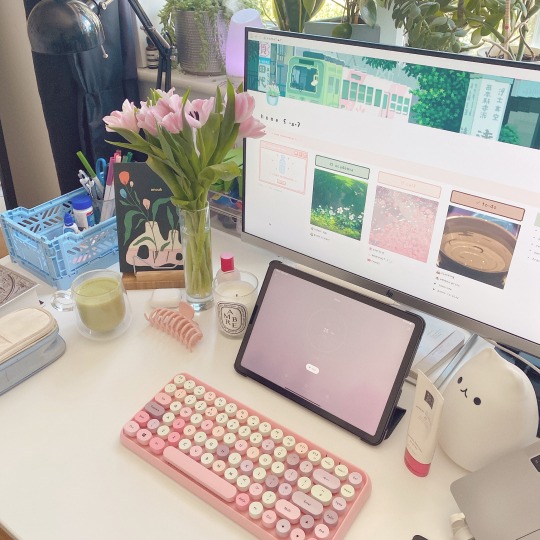

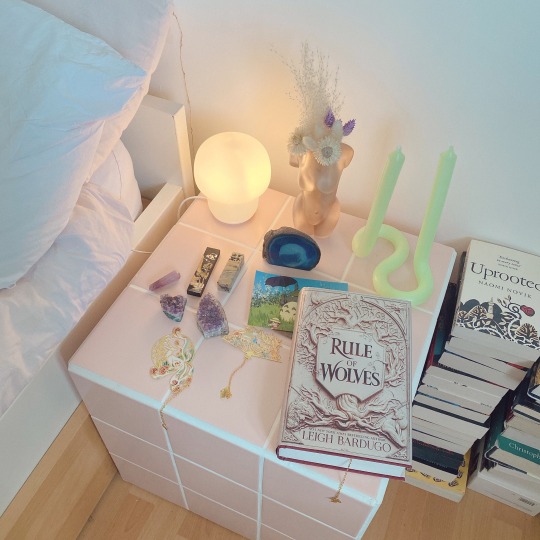

monday, 5th april
picked up some fresh tulips today, decided they deserved their own post + a few pics of my bedroom. i forgot how lovely it is to have flowers nearby :)
3K notes
·
View notes
Photo

I don’t know why did I spend so much money on a workspace when I always end up studying in my bed.
5K notes
·
View notes
Photo
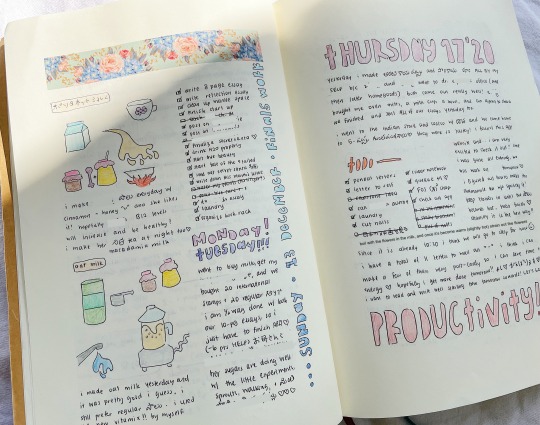
i have a physics exam today and i woke up early to catch up on a last video.
for the first time in my life, i bought myself something online.
it comes on monday, and i’m so excited !
also, i cannot get my dream school out of my head after visiting it…i’ll be so heartbroken if i’m not accepted into that program (ˑ̥̥̥ ˷ ˑ̥̥̥ )
here are some little recipes i sketched out after spending a fun day in the kitchen last year
220 notes
·
View notes
